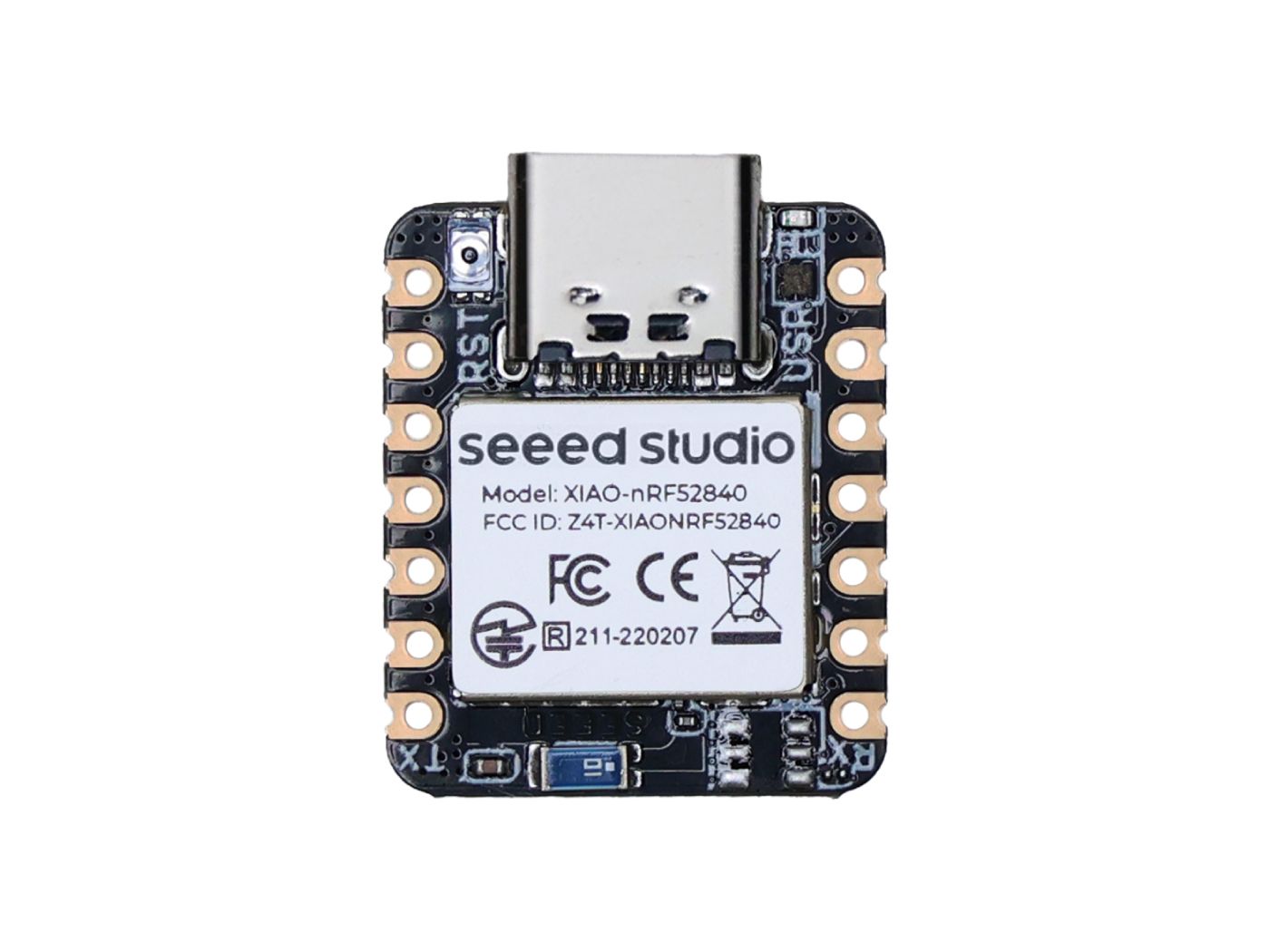Seeed Studio XIAO nRF52840
chip:nrf52, chip:nrf52840
The Seeed Studio XIAO nRF52840 is a general purpose board supplied by Seeed Studio and it is compatible with the Nordic nRF52840 ecosystem as they share the same MCU.

Features
- Nordic nRF52840, ARM® Cortex®-M4 32-bit processor with FPU, 64 MHz
- 256 KB RAM,1MB Flash 2MB onboard Flash
- Bluetooth 5.0/BLE/NFC
- 1xUART, 1xI2C, 1xSPI, 1xNFC, 1xSWD, 11xGPIO(PWM)
- USB Type-C interface
- 1 RGB LED, 1 charge LED
- 1 RESET button
Serial Console
By default, a serial console appears on pins 6 (TX P1.11) and pin 7 (RX P1.12). This console runs a 115200-8N1. The board can be configured to use the USB connection as the serial console.
User LED
The RGB LED is connected as follows:
Color Pin
RED P0.26 GREEN P0.30 BLUE P0.6
Buttons
The Reset button can be used to enter bootloader mode by rapidly clicking it twice. Then, it will enumerate as a storage device to a computer connected via USB. Saving a .UF2 file to this device will replace the Flash ROM contents on the nRF52840.
Pin Mapping
Pads numbered anticlockwise from USB connector.
Pad Signal Notes
0 P0.02 D0/A0 1 P0.03 D1/A1 2 P0.28 D2/A2 3 P0.29 D3/A3 4 P0.04 D4/SDA 5 P0.05 D5/SCL 6 P1.11 Default TX for UART0 serial console 7 P1.12 Default RX for UART0 serial console 8 P1.13 D8/SCK 9 P1.14 D9/MISO 10 P1.15 D10/MOSI 11 12 3V3 Ground Power output to peripherals 13 VIN +5V Supply to board
Power Supply
The working voltage of the MCU is 3.3V. Voltage input connected to general I/O pins may cause chip damage if it's higher than 3.3V.
Installation
- Download UF2 Tools:
git clone https://github.com/microsoft/uf2.git- Configure and build NuttX:
git clone https://github.com/apache/nuttx.git nuttx
git clone https://github.com/apache/nuttx-apps.git apps
cd nuttx
make distclean
./tools/configure.sh xiao-nrf52840:nsh
make V=1- Convert nuttx.hex to UF2 format using U2F Tools:
python3 uf2/utils/uf2conv.py -c -f 0xADA52840 -i nuttx.hex -o nuttx.uf24. Connect the Seeed Studio XIAO nRF52840, and enter bootloader mode by rapidly clicking it twice. The board will be detected as a USB Mass Storage Device. Then copy "nuttx.uf2" into the device.
- To access the console, TX and RX pins must be connected to the device such as USB-serial converter.
Configurations
nsh
Basic NuttShell configuration (console enabled in UART0, at 115200 bps).
usbnsh
Basic NuttShell configuration using CDC/ACM serial (console enabled in USB Port, at 115200 bps).
jumbo
This configuration enabled NuttShell via USB and enabled leds and gpio examples:
Testing leds:
nsh> leds
leds_main: Starting the led_daemon
leds_main: led_daemon started
led_daemon (pid# 3): Running
led_daemon: Opening /dev/userleds
led_daemon: Supported LEDs 0x07
led_daemon: LED set 0x01
nsh> led_daemon: LED set 0x02
led_daemon: LED set 0x03
led_daemon: LED set 0x04
led_daemon: LED set 0x05
led_daemon: LED set 0x06
led_daemon: LED set 0x07Testing gpios:
PIN/GPIO Mode Device
D0/P0.02 Input /dev/gpio0 D2/P0.28 Output /dev/gpio1 D1/P0.03 Input /dev/gpio2
nsh> gpio /dev/gpio0
Driver: /dev/gpio0
Input pin: Value=0
nsh> gpio /dev/gpio0
Driver: /dev/gpio0
Input pin: Value=1
nsh> gpio -o 0 /dev/gpio1
Driver: /dev/gpio1
Output pin: Value=1
Writing: Value=0
Verify: Value=0
nsh> gpio -w 1 /dev/gpio2
Driver: /dev/gpio2
Interrupt pin: Value=0
Verify: Value=1